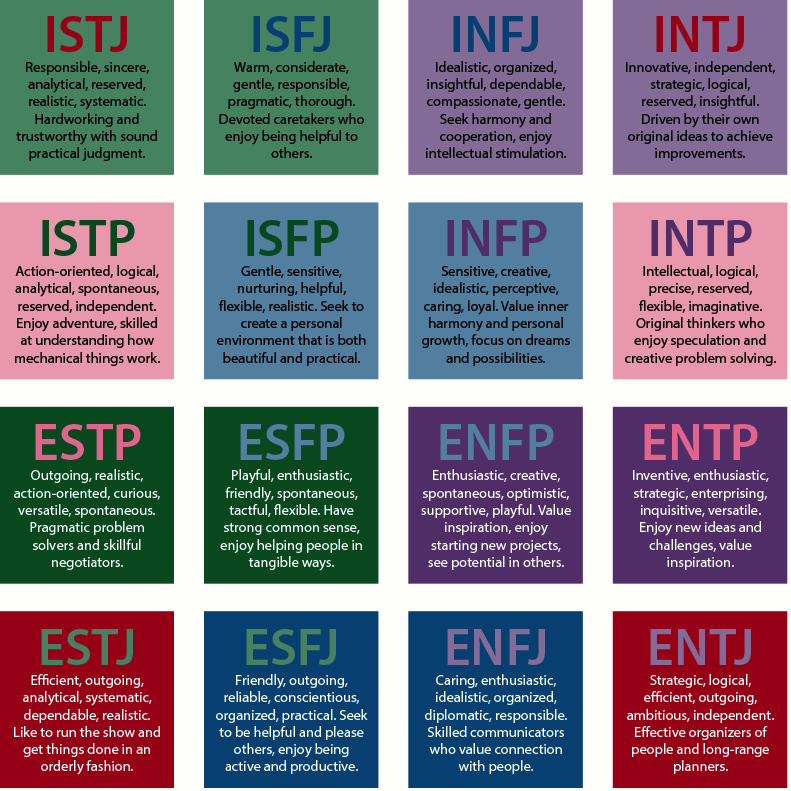
I have tried a psychological test for curiosity, but I need to say that it seems accurate and it has given some interesting insight. I actually took two different tests, administered by two different organizations, which use different sets of questions but the same underlying theory, and the results were still the same. The tests usually don’t take more than 10/15 minutes.
The Test and the Theory
These tests are based on the Myers–Briggs Type Indicator (MBTI) that is an introspective self-report questionnaire indicating differing psychological preferences in how people perceive the world and make decisions.
The original versions of the MBTI were constructed by two Americans, Katharine Cook Briggs and her daughter Isabel Briggs Myers. They based the MBTI on the theory proposed by Swiss psychiatrist Carl Jung, who had speculated that people experience the world using four principal psychological functions – sensation, intuition, feeling, and thinking – and that one of these four functions is dominant for a person most of the time.
The main idea of the theory is that much of what seems random variation in the behavior of people is actually relatively orderly and consistent, because it is due to basic differences in the ways individuals prefer to use their perception and judgment.
NOTE: All the quotes below are taken from Chapter 1 of the 1985 MBTI® Manual: A Guide to the Development and Use of the Myers-Briggs Type Indicator®.
What are Perceptions and Judgments?
In this theory,
“Perception involves all the ways of becoming aware of things, people, happenings, or ideas. Judgment involves all the ways of coming to conclusions about what has been perceived.”
The reasoning behind this is that
“If people differ systematically in what they perceive and in how they reach conclusions, then it is only reasonable for them to differ correspondingly in their interests, reactions, values, motivations, and skills.”
In developing the Myers-Briggs Type the aim of Isabel Briggs Myers, and her mother, Katharine Briggs, was to make the insights of Jung’s type theory accessible to individuals and groups and put it into practical use.

How the MBTI works?
“The MBTI instrument contains four separate indices. Each index reflects one of four basic preferences which, under Jung’s theory, direct the use of perception and judgment. The preferences affect not only what people attend to in any given situation, but also how they draw conclusions about what they perceive.“
The Four Indexes
Extraversion-Introversion (EI)
“The EI index is designed to reflect whether a person is an extravert or an introvert… Extraverts are oriented primarily toward the outer world; thus they tend to focus their perception and judgment on people and objects. Introverts are oriented primarily toward the inner world; thus they tend to focus their perception and judgment upon concepts and ideas. “
Sensing-Intuition (SN)
“The SN index is designed to reflect a person’s preference between two opposite ways of perceiving; one may rely primarily upon the process of sensing (S), which reports observable facts or happenings through one or more of the five senses; or one may rely upon thmeyrs brige less obvious process of intuition (N), which reports meanings, relationships and/or possibilities that have been worked out beyond the reach of the conscious mind.”
Thinking-Feeling (TF)
“The TF index is designed to reflect a person’s preference between two contrasting ways of judgment. A person may rely primarily through thinking (T) to decide impersonally on the basis of logical consequences, or a person may rely primarily on feelings (F) to decide primarily on the basis of personal or social values.”
Judgment-Perception (JP)
“The JP index is designed to describe the process a person uses primarily in dealing with the outer world, that is, with the extraverted part of life. A person who prefers judgment (J) has reported a preference for using a judgment process (either thinking or feeling) for dealing with the outer world. A person who prefers perception (P) has reported a preference for using a perceptive process (either S or N) for dealing with the outer world.”
All of this above may seem complicated but it helps understand better the results and the reason of some of the strange questions you may find in the test.

The Four Preferences
Whether the “official” and paid one from MBTI or free ones from Truity.com or from 16personalities.com they all end up showing your preferences.
These are the four preferences:
Favorite world (E Extraversion or I Introversion): Do you mostly focus on the outer world or on your own inner world?
Information (S Sensing perception or N Intuitive perception): Do you prefer to focus on the basic information you take in or do you prefer to interpret and add meaning?
Decisions (T Thinking judgment or F Feeling judgment): When you need to make a decision, do you focus on logic and consistency or do you focus on the people and special circumstances?
Structure (J Judgment or P Perception): : When you deal with the outside world, do you prefer to get things decided or do you prefer to stay open to new information and options?
The Sixteen Types and Your Personality Type
Each person is said to have one preferred quality from each category/preferences, producing 16 unique types.
According to the theory, one pole of each of the four preferences is preferred over the other pole for each of the sixteen types. The preferences on each index is independent of preferences for the other three indices. Each type is denoted by the four letters of the preferences (e.g., ESTJ, INFP).
The 16 Personality Types in the Table
Below is the table with the 16 Personality Types and their description.

Each of The 16 Types in One Word
Since all of this may seem too abstract, you may find names associated to each group of four letter. For example, I am a ENFJ, and some call this combination the “Teacher”. I will talk about specific types in other blog posts, starting with my own type.
| ISTJ Inspector | ISFJ Protector | INFJ Counselor | INTJ Mastermind |
| ISTP Craftsperson | ISFP Composer | INFP Healer | INTP Architect |
| ESTP Dynamo | ESFP Performer | ENFP Champion | ENTP Visionary |
| ESTJ Supervisor | ESFJ Provider | ENFJ Teacher | ENTJ Commander |

Trackbacks/Pingbacks